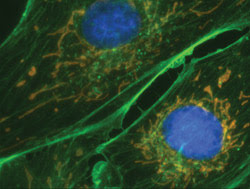Electron-multiplying CCDs are making their way into surveillance, defense and biomedical applications.
Dr. Donal Denvir, Andor Technology Ltd.
Users of detectors for all wavelengths of the spectrum have the same demands year in and year out: faster cameras, better resolution, improved sensitivity, smaller packages and easier-to-use software that will integrate seamlessly with a myriad of applications. Although it may be easy to predict customers’ needs, delivering detectors that exceed — not just match — these expectations is the hard part.
Electron-multiplying CCDs could prove to be the detector package that delivers the speed, sensitivity and resolution demanded by the ultralow-light imaging market. Traditionally, sensitivity has been provided by slow-scan CCDs, but now back-illuminated electron-multiplying CCD technology can provide speed combined with even greater sensitivity. Where longer exposure times are possible, however, a sensitive slow-scan CCD can still be a good choice.

These epifluorescence microscopy cellular images were taken using the iXon DV887-FI camera with an electron-multiplying CCD. Corresponding filter blocks were used to record three consecutive images and were overlaid in software, using pseudocolor to represent each fluorophore.
Electron-multiplying CCDs are beginning to make an impression in the scientific community as well as in the surveillance and defense markets. The next few years will see continued growth of this technology, especially in the high-end detector market, with applications such as single-molecule detection and multidimensional live-cell microscopy, along with Raman spectroscopy, expanding their experimental limits with these supersensitive cameras.
The rate of change will probably accelerate because of competitive forces. Andor is working hand in hand with sensor manufacturers to deliver camera packages that maximize the potential of this technology. Both e2v technologies of Chelmsford, UK, with the L3 Vision sensors, and Texas Instruments of Dallas, with the Impactron devices, are committed to its ongoing development. Significant advances also have been made in thermoelectric cooling, combined with guaranteed vacuum sealing. This has been sufficiently tried and tested to warrant predicting the eventual demise of the use of liquid nitrogen.
In other areas, CMOS technology will continue to improve, but it will not threaten the cooled scientific camera market anytime soon, primarily because it is restricted by noise performance and uniformity, especially in low-light, high-speed applications. But CMOS sensors will continue to appeal to the lucrative low-cost, high-volume market.
In the time-resolved market, there have been moves to deliver less than nanosecond gating, and this will improve. Again, there will be advances in the level of quantum efficiency attainable across the wavelength range.
In terms of interfacing, USB 2.0 and FireWire will increase in popularity as more convenient interfaces for cameras, even though both have speed limitations compared with PCI. It is a trade-off between easy setup and experimental requirements, with the latter being the deciding factor, in most cases.
Meet the author
Donal Denvir is technical director of Andor Technology Ltd. in Belfast, Northern Ireland, responsible for the development of imaging and spectroscopy cameras.